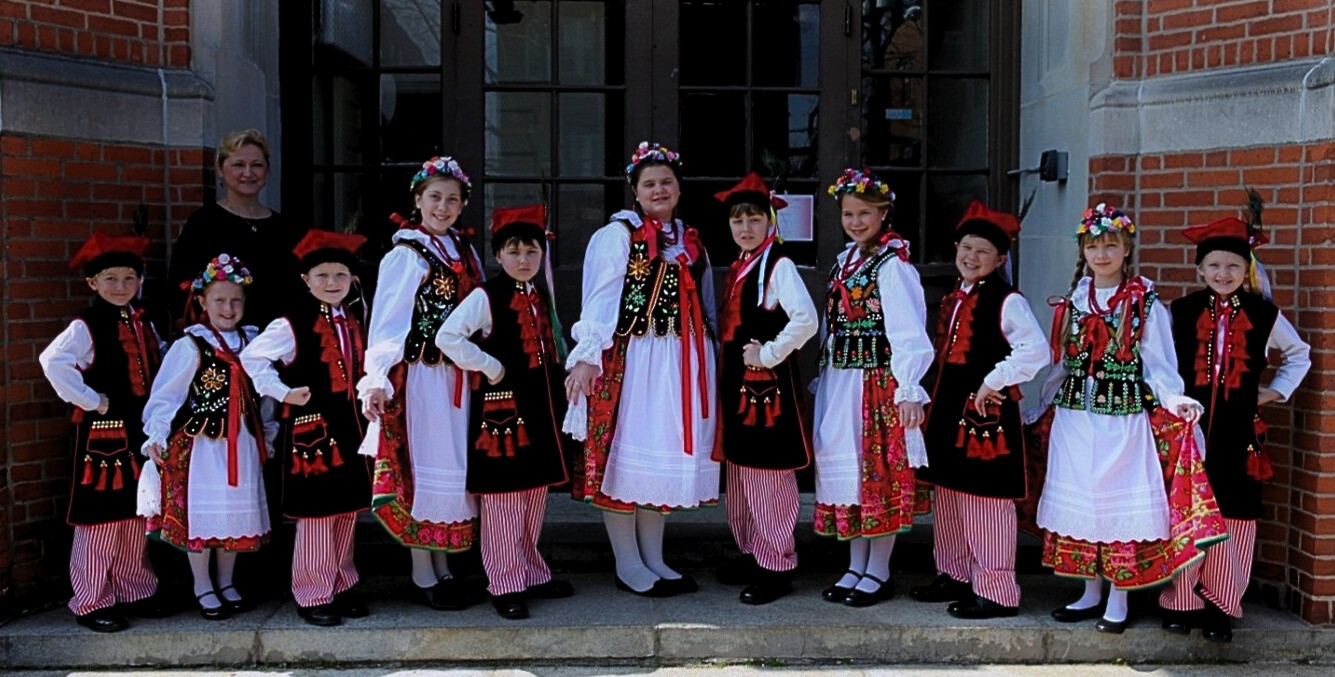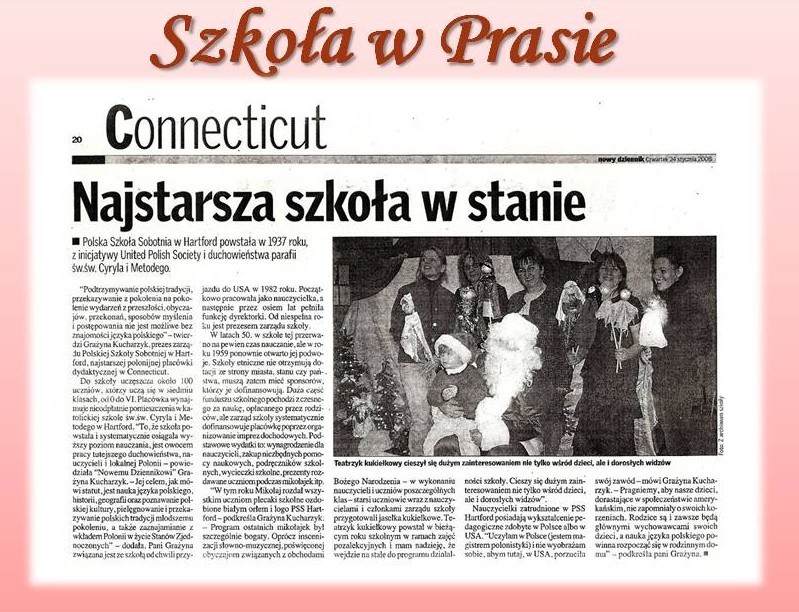“Our goal is to teach the Polish language to children and young people of the new generation of Polish immigrants. We want children to be able to learn about the history, culture and traditions of the country of their ancestors.”
Around 1930, the Polish community in Hartford began to pay attention to the fact that children and young people from Polish families had a poor command of the Polish language.
The reason for this was the migration of the Polish community outside of Hartford and the increase in the number of children attending public schools, which in turn led to less contact with the Polish community and a slow loss of the Polish language.
In June 1932, at a meeting of the Polish Women’s Alliance, Ms. Owsiak put forward a proposal to create a summer school of the Polish language. For unknown reasons, the idea was not implemented, but it was not forgotten.
Like a seed planted in good soil, with the support of the United Polish Societies of Hartford and the priests of St. Cyril and Methodius, on October 6, 1937, the Polish Saturday School in Hartford was opened.
The founding committee provided the school with the necessary books and equipment and entrusted the running of the school to the Felician Sisters. The parish, on the other hand, agreed to use the building of the parish school for this purpose.
In the first year of operation of the Polish Saturday School, 141 children were registered, confirming how much the Polish community in Hartford needed such an institution.
The school year ran from October to June with lessons held every Saturday. The Felician Sisters taught and managed the school, ensuring a high level of education.
At the end of the first school year, on June 23, 1938, it was confirmed with satisfaction that all children had made significant progress in their studies. The artistic program ending this school year was a proof of this, as the children entertained the guests with Polish poems and songs.
These kinds of public performances took place every year and still continue.

However, despite financial support from Monsignor Musięł, the number of registered students was decreasing. In 1950, due to little interest, the Polish Saturday School was discontinued.
Three years later, the Polish Women’s Alliance again made an effort to revive the Polish school of dance and language, but due to the lack of interest from parents and other organizations, this idea was not implemented.
In 1959, a new committee of the Polish Saturday School was founded, which, together with the newly elected president, Jan Bik, and with the support of priests and parishes, led to the revival of the Polish Saturday School.
Ernest Gansziniec became the headmaster of the school, and the teachers were recruited from the Polish community. In the assumptions, it was decided that the school year would last from September to June, and the curriculum, apart from Polish, included “subjects of our fathers”: history and geography.
Lessons were held for three hours every Saturday at the parish school of St. Cyril and Methodius in Hartford. There were also evening classes for adults.
Funding for the school rested on the shoulders of a committee that raised money by organizing games, performances, and collections.

In 1967, the song and dance group Koło Młodych Orła Białego was formed at the Polish Saturday School, which quickly became very well known in the local Polish community.
The group performed as amateurs on the stage of many centers of Polish community life, presenting, among others, “Noc w Polsce” and “Nativity play”.
This period was characterized not only by the involvement of the Polish Saturday School committee, the parish, but also parents. As a result, this contributed to the good financial condition of the school as well as a large number of registered students.
The guiding idea of that period of the Polish Saturday School was a question addressed to parents and their children as a way to promote the Polish language and tradition:
Why do I love Poland?
Dear compatriot, are you sure that your child will understand the subject of these beautiful statements?
„Kocham Polskę, bo Matka moja jest Polką, bo krew, która płynie w mych żyłach jest polska, bo polska jest ziemia, w której pogrzebani są ci, po których płakałem, których czczę, bo miejsce, gdzie się urodziłem, język jakim mówię, książki z których się uczę, brat mój, siostra moja, moi towarzysze, cały ten wielki naród wśród którego żyję, cała ta piękna otaczająca mnie przyroda, to co widzę, co kocham - jest polskie!" Stefan Żeromski.
In 1976, the first statute of the Polish Saturday School was approved, which defined the structure and scope of the school’s activities and was the basis for the development of the current statute of the school.
It was established that the highest authority of the school is the General Meeting of Parents, adopting changes in the statute and approving the school board.
The school organization is governed by the Board, to which the teaching staff and other sections of the organization report.
The activities of the Management Board are controlled by the Audit Committee.

After Ernest Gansziniec, they were successively directors in later years
Janusz Kocur (1984-1995)
Witold Chodulski (1995- 2004)
Teresa Kryla (2004-2007)
Grażyna Kucharzyk (2007-2009)
Krzysztof Dziura (2009-2010)
Anna Gralewska-Mumford (2010-2012)
Izabela Puskarz (2012-2013)
Asha Lassen (2013-2018)
Anna Smerdel-Ramoya (2018-2022)
Lidia Mireles (2022-currently).
The following years and subsequent directors contributed to the continuation of the school’s development and stabilization of its position among Polish organizations in Connecticut.
During Janusz Kocur’s tenure in the 1990s, in order to make lessons more attractive, the teaching process took place not only at school, but also outside its walls.
Traditionally, the oldest classes had history lessons at the Pulaski monument, where they learned respect for tradition and developed a sense of pride in being Polish.
Students also prepared historical and educational academies – one on the occasion of the celebration of Independence Day on November 11 and the other on the occasion of the creation of the Constitution on May 3.
These traditions continue to this day.
During school classes, students of older classes also had the opportunity to stage a typical Polish Christmas Eve with twelve dishes, or a traditional Easter breakfast. During the Valentine’s Day period there was a “pizza party”, and in December there was St. Nicholas’ Day with a visiting Santa Claus and gifts for students. At the end of the school year there was a trip to Riverside Park in MA, Catskill, NY,
In later years, during the term of office of Witold Chodulski. The school trip at the end of the year was held for Polish Days at Lake Compounce in Bristol, CT.
Students also had the opportunity to watch an unforgettable concert by the Dance and Song Group “Mazowsze”.
At that time, the tradition of Dance Games organized for the entire Polish community was initiated, the income from which enriched the school’s budget.
To this day, this tradition continues and still attracts many followers.

Teresa Kryla maintained the traditions of her predecessors and continued the development of the school. Thanks to her, red t-shirts with a white eagle became the symbol of the Polish Saturday School, which our students proudly present at many Polish community celebrations.
The school conducted classes from kindergarten to 6th grade, where highly qualified teachers taught the correct pronunciation and spelling of the Polish language.
In the following classes, elements of Polish grammar were introduced: parts of speech, tenses and the rules of correct spelling. The curriculum also covered the history and geography of Poland.
The entire curriculum at the school was and still is based on the “Curriculum for Polish Schools in the USA” (2005) developed by the Educational Committee of the Polish American Congress, cooperating with the Ministry of Education and the Polish Teachers’ Center in Poland.

In 2008, thanks to Grażyna Kucharzyk, the Polish Saturday School was included in the ranks of the Central Polish Supplementary Schools in America, thus enabling cooperation with other Polish community schools in Connecticut.
The school has been supported many times by the Polish Diaspora Center and the Brother Albert Society, with which it still works closely.
The next step in the development of the school, in order to improve the Polish language, was to establish correspondence between our students and students from the school in Leżajsk.

In 2009, the school was separated from the church of St. Cyril and Methodius.
At the beginning of 2010, Anna Gralewska-Mumford became the president of the school. In February this year, the General Meeting of Parents passed a decision to take steps towards obtaining legal non-profit status.
The result was the association of the school under the legal title of Corporation – Hartford Polish Saturday School, Inc. (Polish Saturday School in Hartford) and the renewal and extension of the school’s statute, which was approved during the General Meeting on March 13, 2010.
During this time, the school went through a series of changes and renewals in order to comply with the standards and requirements of the IRS. A year later, in March 2011, the Polish Saturday School in Hartford was granted non-profit status (Federal Tax Exempt 501(c)(3) Public Charity status).
It was a milestone in the history of the school, contributing to the great pride not only of people associated with the school, but also of the entire Polish community in Hartford.
To celebrate this huge achievement, the parents, board and teachers of the Polish Saturday School organized the first school picnic at Northwest Park in Manchester, CT.

Another novelty in the school was the appearance of the School Newsletter, the aim of which was to inform about school events and announcements, thus increasing close contact with parents.
In 2010, the Polish Saturday School first appeared on the Internet.
The school website (www.PolskaSzkolaHartford.com) and the Facebook social network (www.facebook.com/HartfordPolishSaturdayschool) provide information about the school’s curricula and life.

In recent years, the number of second and third generation children who want to learn the Polish language, culture and traditions of their ancestral country has increased.
The answer to this call was to modify the curriculum in the youngest classes so that children who do not speak Polish could learn Polish as a foreign language.
For the first time, a kindergarten group was created, where 4 and 5 year olds learn Polish through games, plays, music and art.
In 2011, in response to the great interest in continuing to learn Polish, the Polish School opened the seventh grade.

In 2011, the Bursztynki Children’s Choir and the Folk Dance Group Polskie Gwiazdki were created at the Polish Saturday School.
Under the direction of Emilia Zaguła, a choir of 5, 6 and 7 year olds in Kashubian costumes perform at ceremonies, delighting every audience.
Thanks to their skills and personality, Polish Stars led by Jolanta Kobus have enjoyed great popularity from the beginning. Every audience is delighted with their traditional Polonaise and Krakowiak danced in colorful Krakow costumes.
On the occasion of the 75th Jubilee, in order to honor all those who have given their work and their hearts to the Polish Saturday School in Hartford over the last 75 years, the 75th Jubilee Celebration Committee, chaired by Anna Smerdel-Ramoya, funded a school banner.
During the mass in the church of St. Cyril and Methodius, on April 15, 2012, the banner was consecrated and the Banner Funding Act handed over to the school’s board of directors, Anna Gralewska-Mumford, as a symbol of the highest values, honor and tradition of the Polish Saturday School in Hartford, Connecticut.
Prepared by: Stanisław Kryla and the Board of the Polish Saturday School in Hartford
The study used the "History of the parish of St. Cyril and Methodius and the Polish community from Hartford" by Dr. Bolesław S. Kumor and the accounts of former presidents, teachers and activists of the Polish community from Hartford, CT